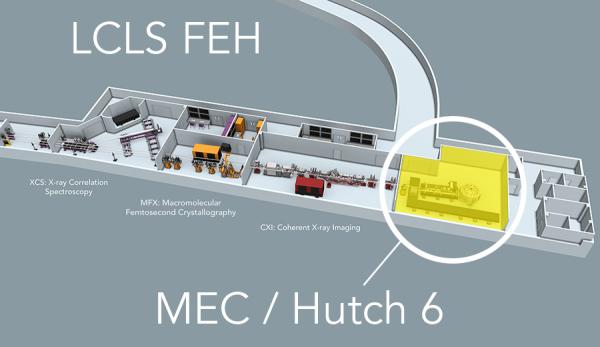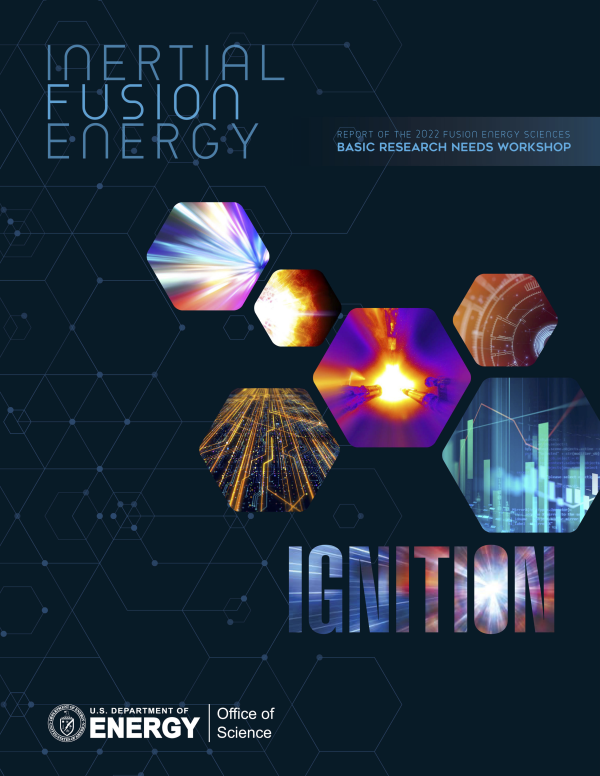MEC (Matter in Extreme Conditions)
The LCLS beam with its high peak brightness, short pulse duration, and tunable X-ray photon energy provides revolutionary capabilities to study the transient behavior of matter in extreme conditions.
The particular strength of the MEC instrument is to combine the unique LCLS beam with high power optical laser beams, and a suite of dedicated diagnostics tailored for this field of science (including an X-ray imaging instrument, large area X-ray detectors for diffraction, a shielded X-ray spectrometer and a VISAR system).
While the large vacuum target chamber makes the endstation very versatile, it has been designed to service key scientific areas including Warm Dense Matter physics, high pressure studies, shock physics, and inertial fusion energy basic research.
VISAR Rapid Access Proposals
VISAR rapid access proposals are reviewed the facility to grant a limited number of laser-only shots in a standard configuration using the VISAR, to be scheduled during the standard configuration block or down time.
1. Fill out the rapid access proposal form
2. Submit the form (any time) through the User Portal
For more information about the MEC instrument, please read the following articles:
- Nagler et al., The Matter in Extreme Conditions instrument at the Linac Coherent Light Source, J. Synchrotron Rad. (2015), 22 (3), 520-525
- S. H. Glenzer, et al., Matter under extreme conditions experiments at the Linac Coherent Light Source J. Phys. B: At. Mol Opt Phys. (2016), 49, 092001
Location
The MEC instrument is located in Hutch 6 of the Far Experimental Hall of LCLS.

Notes from the Run 25 call (now closed)

Proposals to the MEC science area that address inertial fusion energy (IFE) priority research opportunities (PROs) are strongly encouraged. Guidance from DOE anticipates "up to 50%" of user experiments connected to IFE research. We ask that proposals connected to this area clearly self-identify, such as by identifying the relevant PROs from the 2022 IFE Basic Research Needs (BRN) Workshop Report, or science and technology development needs implied by the recent draft report of the FESAC subcommittee on Facility Construction Projects. These proposals will be reviewed by the MEC peer review panel, which includes a sub-panel of experts in the topic. This is part of a broader program to support IFE research at several of LaserNetUS's node facilities. We encourage users to follow the regular proposal template, highlighting IFE in the title or abstract when applicable.
The standard configurations are the same as in Run 24, with Configuration #1 covering XRD and Configuration #2 supporting direct imaging configuration, with imaging lenses placed after the target.
MEC will accept Data Collection and Screening (DC&S) proposals in Run 25. Users are encouraged to consider carefully whether this mode of submission is appropriate for them. Consider the following:
- The experiment must use a standard configuration offered in the run. If you have any doubt in this, please contact an MEC scientist.
- Starting in Run 25, valid DC&S proposals will be considered separately from regular proposals.
- The beam time is intended for completion of an existing data set for publication, ideally (though not necessarily) one collected in one or more MEC experiments in the same configuration.
- The scientific case should be fully defensible using the short-form proposal connected to data set collection (combined with reference to prior accepted LCLS proposals if available). If more space is needed to make a clear scientific case, then a regular standard configuration proposal is more appropriate, regardless of the number of shifts needed.
- The data collection should be achievable within 1 or 2 shifts.
DC&S proposals should use the MEC Short Proposal Form for data set collection
Starting in Run 23, MEC is participating in the rapid-access proposal program to provide laser-only time on the long pulse laser for "VISAR shots." This is a formalized procedure for users to submit targets designed for VISAR diagnosis of shock properties in the MEC standard configuration. Rapid access proposals can be submitted at any time and are assessed by the facility. Users with accepted rapid access time can choose to mail in their targets for shots taken by facility instrument scientists during standard configuration commissioning times. Please use the VISAR Rapid Access Form for these proposals.
In addition to the standard configurations, users are encouraged to take advantage of the following developing capabilities at MEC, in consultation with the Instrument Team:
- A diamond window being added to the beamline will allow better on-shot isolation of the X-ray beamline, making possible in-air alignment and operation at air or poor vacuum. Please consult MEC scientists for details.
- Prototype ultrafast X-ray imaging detectors from Sandia National Laboratory, allowing up to 4 frames separated by few ns, are of particular interest for ns long dynamic studies. These are paired with the developing multi-bucket pulse train capability of the LCLS copper linac. Users should not include this detector in a proposal without explicit discussion with, and approval from, MEC instrument scientists.
- We have begun fielding a pair of VAREX XRD 4343CT detectors for X-ray diffraction, featuring a 43 cm × 43 cm sensitive area (8.3 Megapixels, 150 µm pitch). They are fielded in vacuum-immersion air boxes and can be positioned downstream of the sample, compatible with co-linear long-pulse lasers and VISAR diagnostics. They have been used to provide an angular coverage of roughly 2θ ~ [10°, 85°] and φ ~ [-70°, 70°]; [110°-250°]. They are designed for high photon energy and have been tested at 17 keV and above. Users should not include this detector in a proposal without explicit discussion with, and approval from, MEC instrument scientists.
Multimedia
MEC CONTACTs
Eric Galtier
MEC Instrument Lead
(650) 926-6227
egaltier@slac.stanford.edu
Ariel Arnott
Area Manager
(650) 926-2604
amarnott@slac.stanford.edu
Gilliss Dyer
MEC Department Head
(650) 926-3414
gilliss@slac.stanford.edu
Hae Ja Lee
Lead Scientist
(650) 926-2049
haelee@slac.stanford.edu
Philip Heimann
Senior Scientist
(650) 926-8772
paheim@slac.stanford.edu
Dimitri Khaghani
Staff Scientist
(650) 926-5009
khaghani@slac.stanford.edu
Bob Nagler
Staff Scientist
(650) 926-3810
bnagler@slac.stanford.edu
Nick Czapla
Associate Laser Scientist
(650) 926-4314
nczapla@slac.stanford.edu
Nina Boiadjieva
Staff Engineer
(650) 926-4035
ninab@slac.stanford.edu
Peregrine McGehee
Staff Engineer
(650) 926-1631
peregrin@slac.stanford.edu
Philip Hart
Staff Engineer
(650) 926-2813
philiph@slac.stanford.edu
Marc Welch
Staff Engineer
(650) 926-3754
mwelch@slac.stanford.edu
Jonathan Ehni
Science & Engineering Associate
(650) 926-4562
jonehni@slac.stanford.edu
-
MEC Control Room
(650) 926-7970
MEC Hutch
(650) 926-7974
Vestibule
(650) 926-7976


